If the stressed reports that I am hearing about students having three exams this week are true more widely, then it would seem that many of us are planning early assessments in our courses. You might consider adding an “exam wrapper” of some kind to that assessment. Thinking of it prompted me to pull out this post from 2020:
The goal of an exam wrapper is to help students to reflect on their performance, typically noting exam questions that they got wrong or commentary on an essay. An exam wrapper provides a structured way for students to reflect and can promote metacognition.
There are three general types of wrapper questions:
1. Asking students the process they used to prepare for an exam or complete an assignment. This is a question that you might raise before an exam or as students are turning in their work.
- As a prompt before the exam, a variant could be used to help put anxious students at ease.
- A question about time spent could be used to help students to assess whether they studied sufficiently.
- Asking students to assign the amount of time they spent on specific aspects of an assignment can be used to teach process such as essay writing writing process.
2. Asking students to assess their own performance on an exam or assignment.
- Students might be asked to read an assignment they are submitting and use a rubric to grade it themselves.
- Upon returning an exam, a prompt might ask students to identify the errors or patterns of error; they might determine correct answers and submit for additional credit.
- A reflection question upon return might ask students to review the questions and assess the level of difficulty or the kinds of operations required to answer a particular type of question.
3. Asking students to plan for their next exam or assignment in light of what they have learned.
- Students might be asked to create a study plan based on how the outcome aligns with their process of study or completion of the assignment.
- They might be asked to review previous exams in anticipation of a final exam.
- This might be good to collect and distribute back to students as they near the next assessment.
We all know that many of our students look mainly to the grade of an assignment (if they seek that feedback at all), and many tend to avoid reviewing the exam or reading the written feedback on an assignment. Using an exam wrapper can be one way to guide students through the feedback; it can help them to learn how to make use of it (rather than fearing it as a judgment or basis of their self-worth).
Although it is a quick and relatively easy metacognitive task, it can improve their learning of the material tested by the exam or exercised by the assignment. For more on cognitive wrappers, the educational theory and some excellent process reflections, see this blog post on Cognitive Wrappers: Using Metacognition and Reflection to Improve Learning by Jose Antonio Bowen.
For more on how to employ exam wrappers using Canvas tools, have a look at Instructional Design Consultant Gary Ackerman’s workshop on Conditional Release in Canvas.



